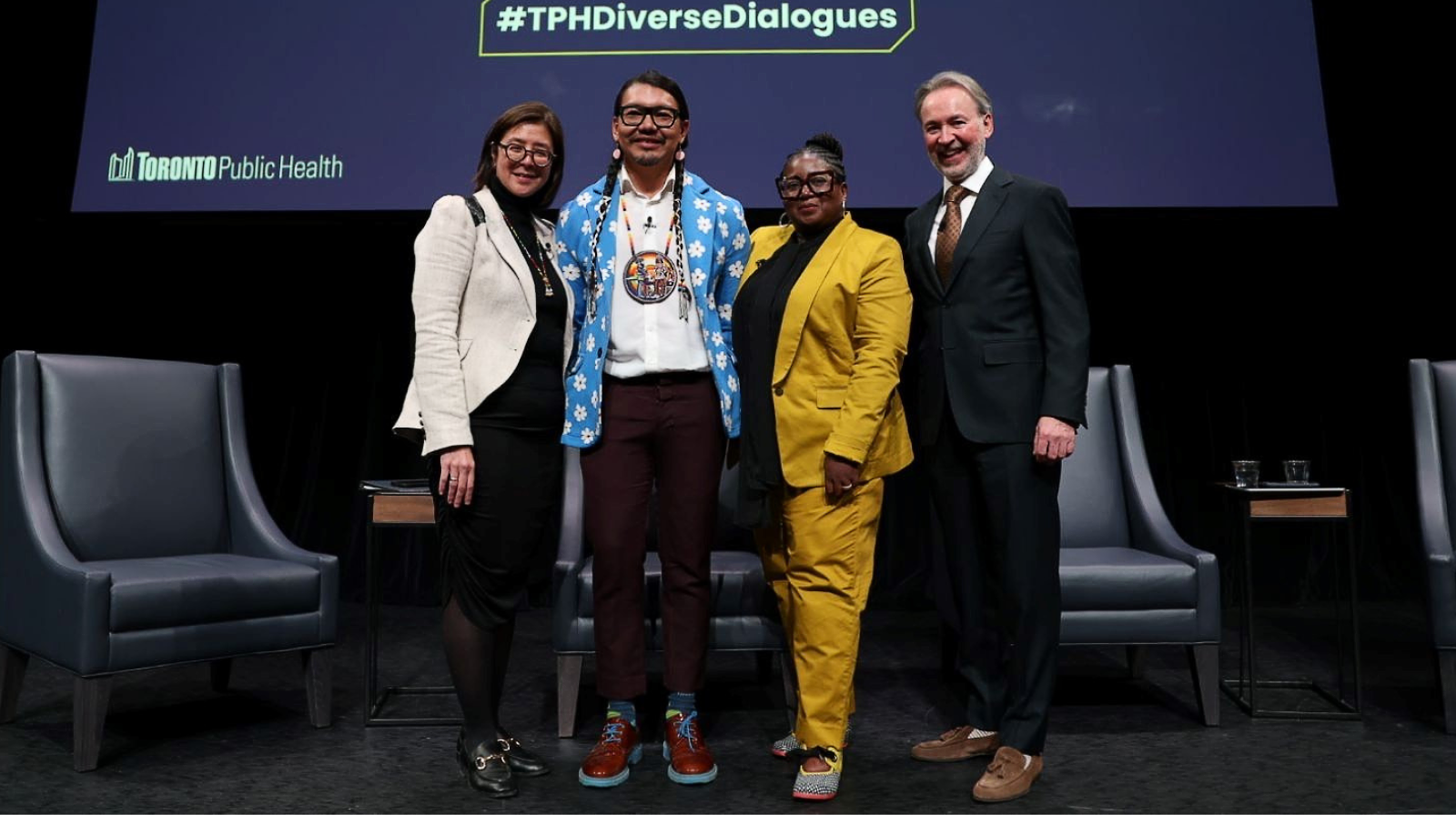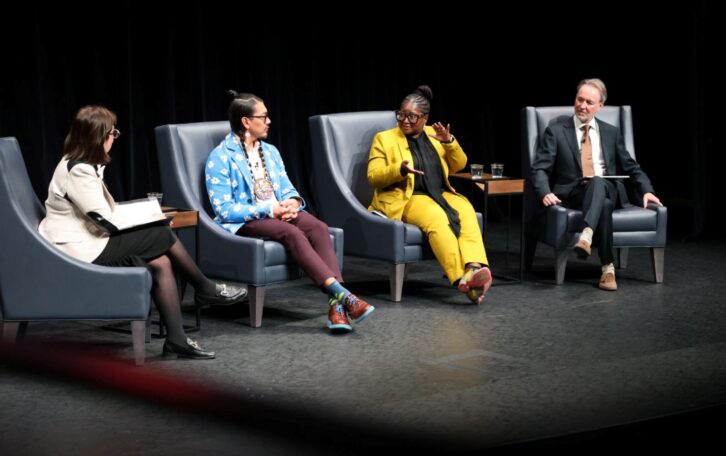Crushing It

Subscribe to Catalyst
Subscribe to get our magazine delivered right to your inbox
Related Articles
Subscribe to Catalyst
Subscribe to get our magazine delivered right to your inbox
Related Articles
What prevents people from seeking help?
For some, it’s a lack of resources—usually time or money. Others may not even be aware that help is available.
Sometimes, people postpone seeking help for a totally different reason, namely, that they’re worried about how they’re going to be treated by the health-care system. They worry about stigma.
“Stigma is something that we deal with every single day,” says Dr. Eileen de Villa, Toronto’s Medical Officer of Health. “Toronto, like many other areas, is grappling with the intertwined challenges of homelessness, pervasive mental illness, and untreated addiction.”
She hosted an event called Diverse Dialogues: Stigma & Breaking Barriers in Toronto in May as part of the annual Charles Hastings Lecture series.
Dr. De Villa calls this an unprecedented “triple crisis” that demands a solution from all three levels of government, listing stigma as one of the major roadblocks in the path to addressing this crisis.
“People say ‘If only they could get their act together’ or ‘If only they had made better life choices,” says Dr. de Villa, “but addiction is a complex disease, not a moral failing,” she says.
Types of stigma
“Stigma creates a web of shame, fear of judgment, and isolation,” she continues. “The fear of criminalization makes it far less likely that someone will seek help and, when they finally do work up the courage to seek out help, the discriminatory attitudes they can face within our health-care system don’t support the path to recovery.”
And, as Dr. de Villa points out, this is just one of the ways in which stigma impacts our population.
What, exactly, is stigma? Well, it’s as complicated as it is pervasive. At face value, most of us know that stigma is in the same family of words as “stain,” “scar,” and “mark of shame,” and generally means something along the lines of “an unfair belief about a person or a group of people.”
Current research frames stigma as the presence of a socially undesirable characteristic which signals ‘otherness’ according to research from the Mental Health Commission of Canada (MHCC). That research focuses on four types of stigma, explains MHCC president and CEO Michel Rodrigue, who was part of Toronto Public Health’s Diverse Dialogues event.
There is individual stigma which is largely about internalizing negative messages. The second is interpersonal stigma, which, he says, can arise in relationships with friends, family, and colleagues.
Structural stigma encompasses organizational rules, policies, procedures, laws, and cultural norms that perpetuate and increase stigmatization. Intersectional stigma, which happens when stigma related to mental health or substance use overlap with other forms of inequities.
Thanks to a growing body of research that’s built up a taxonomy of stigma, it’s been easier to identify the ways that stigma, particularly structural and intersectional stigma, have been used to marginalize populations.
Lived experiences with stigma
“Stigma does not exist without marginalization and discrimination,” explains Dr. Notisha Massaquoi, assistant professor in the Department of Health and Society at the University of Toronto Scarborough, who spoke at the event and participated in the panel discussion. “Stigma is a core and essential tool within anti-Black racism.”
Dr. Massaquoi says we can’t separate stigma from other tools of oppression, notably erasure and invisibility, but also marginalization and isolation. Stigma serves to distract us from systemic barriers to health and has a profound negative impact on the health of the population.
“Stigma undermines every aspect of the health-care cascade,” says Dr. Massaquoi, “It undermines diagnosis, it undermines treatment, it undermines equitable access to care, and it undermines successful outcomes.”
Before working at the university, Dr. Massaquoi worked in public health, first as a service provider for continental African people in Toronto newly diagnosed with HIV. That was in the late 1980s, before medical treatment was available. She says that every day, she hoped nobody would walk through her door because every client she saw would pass away within a year.
“When we did get medication, when AZT (a type of anti-HIV retroviral drug) first arrived in Canada, what I saw were the effects of stigma,” she recalls. “African people were blamed for bringing HIV to Canada and stigmatized in terms of being accused of having unusual sexual practices. All kinds of stigmatizing labels were given to this community.”
That led to people losing their jobs. And, Dr. Massaquoi adds, if they were discovered to be HIV-positive, health-care providers dropped them from their rosters. Toronto’s Black community was the last to access medication.
Sometimes discrimination comes from structural barriers that are difficult to perceive, such as the lack of HIV/AIDS clinics in parts of the city with large Black communities, even though the incidence of HIV infection is higher in those populations. That disparity is finally being addressed now, but it persisted for years.
Other times, though, discrimination and stigma in the medical system is blatant and undeniable.

“On my first day of residency as a physician in the Victoria General Hospital, a nurse chose to stop me from going in to deliver a baby by grabbing my braid and yelling at me,” recalls Dr. James Makokis, two-spirit family physician in Saddle Lake Cree Nation, Alberta, and season seven winner of The Amazing Race Canada, who also spoke at the event.
“When we think about what happens to Indigenous patients who have far less power than me as a physician,” says Dr. Makokis, “then it makes sense that we have people like Joyce Echaquan who literally filmed her death on social media while she was being called the exact stereotypes that Indigenous peoples are often labelled with. Like that she was only good for sex.”
Echaquan, a 37-year-old Atikamekw woman, died of a pulmonary edema in a hospital in Joliette, Quebec, in September 2020, after being restrained and given morphine. Her family claims she was allergic to morphine and had expressed concerns over a potential adverse reaction.
As she was dying, she recorded and live-streamed a seven-minute video of nurses insulting her, calling her “stupid as hell” and blaming her health problem on “bad choices.”
Dr. Makokis says acts like this, which blatantly expose structural racism, are enabled by dehumanization. In turn, dehumanization is supported by stigma. It’s all part of the same logic of white supremacy that justified and enabled colonization and genocide.
“Part of dehumanization is suggesting that a group of people has less intelligence or morality,” he says. “And we can think about that in terms of Indigenous people who were often taught only up to grade six in residential schools because they were thought to only have the mental capacity to achieve that level.”
There are other components of dehumanization—suggesting that a population is an “infestation” and characterizing those people as “savages” or “cockroaches.” All of this helps to justify violence, injustice, and systemic inequity.
“You are not the same as me,” continues Dr. Makokis. “I am better than you. You are less human than me. And when that happens, it’s a core component of dehumanization, which means that we can do anything to a group of people, and they just become a collection of stereotypes.”
What can we do?
Dr. Makokis says that Canadians like to (falsely) believe we live in a post-racial nation of kind peacekeepers and that discrimination is a thing of the past. He, as well as Rodrigue, Dr. de Villa, and Dr. Massaquoi, all point to education as the first step in dismantling systemic racism.
We learn little or nothing in public schools about genocide, residential schools, or the contributions made to society by Black Canadians—and that invisibility and erasure are the first steps towards stigmatization. If we start there, we can help stop dehumanization and stigma before it starts. After that, Dr. Massaquoi says race-based data is key, so we can advocate for stigma-free services that are truly accessible to the communities that are most in need.
Viewing stigma through a public health lens is an excellent way to understand that public health is a key pillar to the fabric of society. As the pandemic demonstrated, we are all connected in ways we don’t always understand until we are in crisis.
“We have always worked towards justice,” says Dr. Makokis. “And it’s important to remember Dr. Luther Martin King’s words on the matter. ‘Injustice anywhere is a threat to justice everywhere. We are caught in an inescapable network of mutuality, tied in a single garment of destiny. Whatever affects one directly, affects all indirectly.’”
Video: See the 2024 Charles Hasting Lecture on the Toronto Public Health YouTube channel.
Resource: Structural Stigma: An implementation guide to making real change for and with people living with mental health problems or illnesses and/or substance use concerns.
Photos: Courtesy, Toronto Public Health




